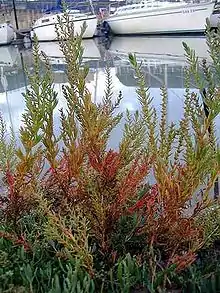Suaeda
Suaeda is a genus of plants also known as seepweeds[1] and sea-blites. Most species are confined to saline or alkaline soil habitats, such as coastal salt-flats and tidal wetlands. Many species have thick, succulent leaves, a characteristic seen in various plant genera that thrive in salty habitats (halophile plants).
| Suaeda | |
|---|---|
 | |
| Suaeda maritima | |
| Scientific classification | |
| Kingdom: | Plantae |
| Clade: | Tracheophytes |
| Clade: | Angiosperms |
| Clade: | Eudicots |
| Order: | Caryophyllales |
| Family: | Amaranthaceae |
| Subfamily: | Suaedoideae |
| Genus: | Suaeda Forssk. ex J.F. Gmel. |
| Species | |
|
About 110 | |
There are about 110 species in the genus Suaeda.[2]
The most common species in northwestern Europe is S. maritima. It grows along the coasts, especially in saltmarsh areas, and is known in Britain as "common sea-blite", but as "herbaceous seepweed" in the USA. It is also common along the east coast of North America from Virginia northward. One of its varieties is common in tropical Asia on the land-side edge of mangrove tidal swamps. Another variety of this polymorphic species is common in tidal zones all around Australia (Suaeda maritima var. australis is also classed as S. australis). On the coasts of the Mediterranean Sea a common Suaeda species is S. vera. This is known as "shrubby sea-blite" in English. It grows taller and forms a bush.
The name Suaeda comes from an oral (non-literary) Arabic name for the Suaeda vera species transliterated as suaed, sawād or suēd,[3] and it was assigned as the genus name by the 18th century taxonomist Peter Forsskål during his visit to the Red Sea area in the early 1760s.[2][4] Forsskål's book, Flora Aegyptiaco-Arabica, published 1775, in Latin, declares Suæda as a newly created genus name, with the name taken from an Arabic name Suæd and presents the species members of the new genus.[5]
The genus includes plants using either C3 or C4 carbon fixation. The latter pathway evolved independently three times in the genus and is now used by around 40 species. S. aralocaspica, classified in its own section Borszczowia, uses a particular type of C4 photosynthesis without the typical "Kranz" leaf anatomy.[6][7][8]
Uses
In the medieval and early post-medieval centuries suaeda was harvested and burned, and the ashes were processed as a source for sodium carbonate for use in glass-making; see glasswort. In Mexico, some species such as Suaeda pulvinata, called romeritos, are cooked in a traditional festive dish called either revoltijo or romeritos. It is also eaten as wild greens (quelites), or as edible herbs grown as part of the crop-growing system called milpa.
Selected species
- Suaeda aegyptiaca
- Suaeda aralocaspica – formerly known as Borszczowia aralocaspica
- Suaeda asphaltica – Asphaltic seablite
- Suaeda australis – Austral seablite
- Suaeda calceoliformis – Pursh seepweed, broom seepweed, horned seablite
- Suaeda californica – California seablite
- Suaeda conferta – beach seepweed
- Suaeda corniculata
- Suaeda depressa – Alkaki seepweed
- Suaeda esteroa – estuary seablite
- Suaeda fruticosa
- Suaeda glauca
- Suaeda japonica[9]
- Suaeda linearis – annual seepweed, narrow-leaf seablite
- Suaeda maritima
- Suaeda mexicana – Mexican seepweed
- Suaeda monoica
- Suaeda novae-zelandiae
- Suaeda nigra – bush seepweed, romerillo
- Suaeda occidentalis – western seepweed
- Suaeda palaestina
- Suaeda pulvinata
- Suaeda rolandii – Roland's seablite
- Suaeda salina
- Suaeda salsa
- Suaeda suffrutescens – desert seepweed
- Suaeda tampicensis – coastal seepweed
- Suaeda taxifolia – woolly seablite
- Suaeda torreyana – iodine weed
- Suaeda vera
- Suaeda vermiculata
References
- USDA, NRCS (n.d.). "Suaeda". The PLANTS Database (plants.usda.gov). Greensboro, North Carolina: National Plant Data Team. Retrieved 4 December 2015.
- Ferren, Wayne R., Jr.; Jochen Schenk, H. (2003). "Suaeda". In Flora of North America Editorial Committee (ed.). Flora of North America North of Mexico. Vol. 4. Oxford: Oxford University Press. pp. 260, 360, 389, 390. ISBN 9780195173895.
{{cite book}}: CS1 maint: multiple names: authors list (link) - Article Soda, by Arnald Steiger, year 1937, on pages 74-75
- Entry for Suaeda in the Jepson Manual Online.
- Flora Aegyptiaco-Arabica pages XXXVIII, 69-71
- Schütze, P.; Freitag, H.; Weising, K. (2003). "An integrated molecular and morphological study of the subfamily Suaedoideae Ulbr. (Chenopodiaceae)". Plant Systematics and Evolution. 239 (3–4): 257–286. doi:10.1007/s00606-003-0013-2. ISSN 0378-2697. S2CID 20250636.
- Kapralov, M.V.; Akhani, H.; Voznesenskaya, E.V.; Edwards, G.; Franceschi, V.; Roalson, E.H. (2006). "Phylogenetic Relationships in the Salicornioideae / Suaedoideae / Salsoloideae s.l. (Chenopodiaceae) clade and a clarification of the phylogenetic position of Bienertia and Alexandra using multiple DNA sequence datasets". Systematic Botany. 31 (3): 571–585. doi:10.1600/036364406778388674. ISSN 0363-6445.
- Sage, R.F. (2016). "A portrait of the C4 photosynthetic family on the 50th anniversary of its discovery: species number, evolutionary lineages, and Hall of Fame". Journal of Experimental Botany. 67 (14): 4039–4056. doi:10.1093/jxb/erw156. ISSN 0022-0957. PMID 27053721.

- "Suaeda japonica". www.uniprot.org.